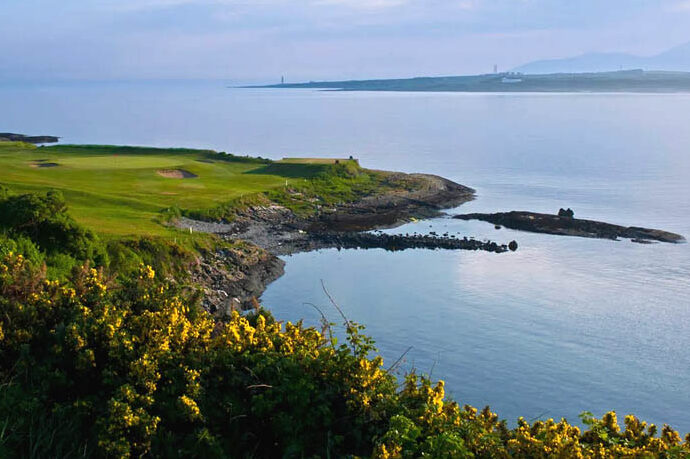Golf, the wind and the Irish Sea
A trip to Northern Ireland for a friend’s wedding had me up in the air about taking my clubs for just two rounds of golf. But two delightful days at Cairndhu and Ardglass golf clubs proved that my rule of at least three rounds was made to be broken.
We’ll not dwell on the unpleasantness of the return, which had me and thousands of other American Airlines passengers stranded at Dallas-Fort Worth International Airport – in my case for 30 hours. But once at home, a fast-forward of the week’s network newscasts on the DVR revealed the horrendous weather that preceded my arrival at DFW. One video clip showed a parked Boeing 737 being blown sideways away from a DFW jet bridge.
But in Northern Ireland, before all that, there was golf – delightful golf Northern Ireland-style. Thanks to the efforts of another wedding guest, New York golf writer Dave Donelson, who did the driving, I realized that the less-famous courses of Northern Ireland are worthy of any golf traveler’s attention.
Cairndhu: So steep “even the locals take buggies’
Cairndhu Golf Club was first on the agenda. Jeff Neuman, former managing editor of The Met Golfer magazine in New York City, whose wedding Dave and I attended, knows Cairndhu, as he lives part time near Belfast. Jeff made clear the terrain at Cairndhu is so steep “even the locals take buggies.”

As Dave and I turned in to the course from the Coast Road and climbed to the clubhouse, passing near the abandoned estate house for which the course is named, the severity of the terrain manifested itself. Google Earth topography shows that the lowest point on the course is 55 feet above sea level and the highest is 239 feet. The course ascends and descends the 184 feet in between again and again, often straight up or straight down.
Cairndhu is a mini Rock of Gibraltar perched above the Irish Sea. From its highest point you take in sweeping views of the coastline curving north toward Ballycastle; to the east, across the water to the west coast of Scotland.
The par 70 parkland course plays between 5,374 and 5,854 yards. While that sounds short, for us, playing on a wet and foggy day, some uphill par 4s weren’t reachable in two shots and, somehow, the downhill holes didn’t seem to offset that disadvantage.
No. 1, for example, a 360-yard par 4, plays straight uphill with the journey up the fairway starting out at a 6-percent grade, then steepening to 10, 12 and almost 14 percent within 100 yards of the green.
Cairndhu: Deceptively narrow fairways
The true test of Cairndhu, though, lies in its intimidating sight lines from the tee box, with trees seemingly crowding the fairways from both sides, tricking the golfer into thinking the fairway is a mere 10 to 15 yards wide, when in fact they’re typically 35 yards wide.

Wayne Telford, head professional at Cairndhu, said the fairways used to be wider. “We tried to bring it in visually just to make it a little bit more intimidating,” he said. At the same time, the rough was cut down to make missing the fairway less punitive.
“I want you to come and tackle the golf course that we have,” he said. “It’s not the longest in the world, but most certainly it’s interesting. And you’ve got to learn how to play this course. We have some of the best golfers from all over the country come to play it, and they never shoot low scores around it, especially the first time.”
For the spry among us, Cairndhu’s walking rate for visitors is £75. A cart is another £30. Telford made a point to mention that the hospitality that his club’s members show to visiting golfers will to make the 26-mile 40-minute drive from downtown Belfast worthwhile.
Ardglass: Links golf and views of the Irish Sea

Next up was Ardglass Golf Club. Our round there was arranged by Jeff, our newlywed friend, who, despite being married just four days earlier, booked himself, Dave and me as a threesome with caddies. God bless his bride, Sherry.
Our round fell on the course’s “Senior Open Day.” That’s when anyone 50 or older can play the course as part of an organized competition at a fraction of its rack rate. Senior opens are held periodically at many courses across the United Kingdom. In fact, if you’re 50 or over, booking a Senior Open round that works for your vacation itinerary can allow you to play a big-name course at a fraction of the normal price. In our case, we paid £70, down from the visitors’ high-season weekday rate of £170.
Ardglass Golf Club is in the tiny seaside town of Ardglass in County Down, on the northeast coast of Northern Ireland. It’s just under an hour’s drive southeast from Belfast. The three of us rolled in with just enough time to pop in at the local Doc’s Fish & Chips, which served the best I’ve had in about a dozen trips to the U.K. and Ireland.

Ardglass lays claim to the oldest clubhouse in golf (1405), which was built as a sort of customs house for goods flowing through the harbor it overlooks. The course started out in 1896 as a seven-hole layout measuring less than 1,000 yards and didn’t become an 18-hole course until the 1960s.
It’s a links course and generally flat, perched about 40 feet above the rocky coastline of the Irish Sea. The par 70 layout plays between 5,305 and 6,216 yards and there is only about 60 feet of elevation change across the course, making it eminently walkable.
Ardglass has the look and feel of your mind’s eye’s vision of a links course: the ever-present wind, views of the ocean from all 18 holes, small, undulating greens, many with with false fronts, firm fairways, sod-lined pot bunkers, and deep primary rough that rarely gives up a mishit golf ball. On the course’s website, PGA Championship winner Rich Beem says Ardglass “has some of the best views in golf.”
At the mercy of the wind at Ardglass
On the day our threesome played, the sun was shining but Ardglass’s typical 10- to 20-mile-an-hour winds were blowing between 25 and 40 miles an hour, according to our caddies Ewan and Barry. That made club selection on downwind holes a real crapshoot, despite the caddies’ local knowledge. Upwind holes were a slog and it was quite the challenge to pick a good line for shots in the howling crosswinds.

Typical was the par 3. 180-yard 12th hole, “Cathlin,” a dramatic downhill hole framed by its ocean backdrop that played straight downwind. I hit a hybrid that usually goes 150 to 155 yards and flew the green by a good 20 yards, proving the club’s claim, “It is just about impossible to play ‘yardage-based’ golf on this links.”
The holes at Ardglass were fun and memorable. The caddies’ reads were spot on. Birdies on 5 by Jeff and on 11 by Dave were highlights, and I managed to eke out a few pars, but the truth is that Ardglass and its winds administered a severe beating to the three of us. While I stopped keeping score early on, and Dave had his own travails, Jeff alone soldiered on, putting out everything and posting a score at the day’s end before we headed upstairs for a pint and a bite in the club’s welcoming dining room.
I can see why several prominent golf writers have called Ardglass one of their favorite courses anywhere, and it brought a smile to my face to take the hole-by-hole flyover tour on Ardglass’s website once I got home. The next time I head to Northern Ireland, this spectacular links course absolutely will be on my list for a rematch.
Dan Vukelich is the online editor of Alabama Golf News
Have a story idea or a suggestion for Alabama Golf News? Email gregg@alabamagolfnews.com
Featured image of the 12th hole courtesy of Ardglass Golf Club







